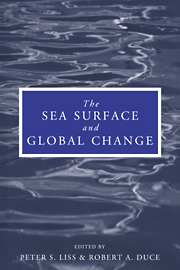Book contents
- Frontmatter
- Contents
- List of contributors
- Preface
- 1 Report Group 1 – Physical processes in the microlayer and the air–sea exchange of trace gases
- 2 Report Group 2 – Biological effects of chemical and radiative change in the sea surface
- 3 Report Group 3 – Photochemistry in the sea-surface microlayer
- 4 Transport processes in the sea-surface microlayer
- 5 The role of organic films in air–sea gas exchange
- 6 Bubbles and their role in gas exchange
- 7 The physical chemistry of air–sea gas exchange
- 8 The sea-surface microlayer and its effect on global air–sea gas transfer
- 9 Chemistry of the sea-surface microlayer
- 10 Biophysics of the surface film of aquatic ecosystems
- 11 Biological effects of chemicals in the sea-surface microlayer
- 12 Neuston of seas and oceans
- 13 Photochemistry in the sea-surface microlayer
- 14 Hydrocarbon breakdown in the sea-surface microlayer
- 15 Applications of laser technology and laser spectroscopy in studies of the ocean microlayer
- 16 Remote sensing of the sea-surface microlayer
- Index
1 - Report Group 1 – Physical processes in the microlayer and the air–sea exchange of trace gases
Published online by Cambridge University Press: 24 September 2009
- Frontmatter
- Contents
- List of contributors
- Preface
- 1 Report Group 1 – Physical processes in the microlayer and the air–sea exchange of trace gases
- 2 Report Group 2 – Biological effects of chemical and radiative change in the sea surface
- 3 Report Group 3 – Photochemistry in the sea-surface microlayer
- 4 Transport processes in the sea-surface microlayer
- 5 The role of organic films in air–sea gas exchange
- 6 Bubbles and their role in gas exchange
- 7 The physical chemistry of air–sea gas exchange
- 8 The sea-surface microlayer and its effect on global air–sea gas transfer
- 9 Chemistry of the sea-surface microlayer
- 10 Biophysics of the surface film of aquatic ecosystems
- 11 Biological effects of chemicals in the sea-surface microlayer
- 12 Neuston of seas and oceans
- 13 Photochemistry in the sea-surface microlayer
- 14 Hydrocarbon breakdown in the sea-surface microlayer
- 15 Applications of laser technology and laser spectroscopy in studies of the ocean microlayer
- 16 Remote sensing of the sea-surface microlayer
- Index
Summary
Surface films
Sources, sinks, and properties of surface films
Sea-surface films are derived from multiple sources, both in the sea and on land. Even in oligotrophic waters where biological productivity is low, the concentration of dissolved organic matter, including degraded biopolymers and geopolymeric materials, is sufficient to produce surface enrichments of organic matter under favourable physical conditions. Specific inputs from phytoplankton blooms and from neuston indigenous to the microlayer also contribute to the enrichment of surface-active matter at the interface. Terrestrial sources include both natural and anthropogenic contributions. Terrestrial plant-derived materials are released directly to the atmosphere and introduced via dry and wet deposition, or enter the ocean environment via riverine inputs as decay products of vegetation. Anthropogenic contributions include point sources related to industrial processes, agricultural runoff, and spills of petroleum products (catastrophic and chronic). In addition, municipal wastewater discharges are frequently highly enriched in surfactants that ultimately enter coastal seas and sediments. In shallow coastal environments, resuspension of sediments and release of sediment pore-water materials are other potential sources of surfactants.
The relative importance of these sources is not known. A major source of surfactants is thought to be production by phytoplankton, which exude natural surfactants as metabolic by-products (Zutic et al., 1981).
- Type
- Chapter
- Information
- The Sea Surface and Global Change , pp. 1 - 34Publisher: Cambridge University PressPrint publication year: 1997
- 6
- Cited by



